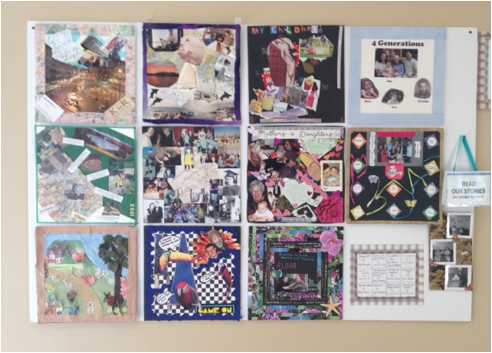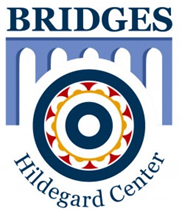My Story Quilt
My Story Quilt
Lesson Submitted by Cathy Harrington and Marilyn Stadler With Links to Dick Blick Copyrighted Lesson Plans “Painted Story Quilt” “Quilt Block Collage” And “Paper Memory Quilt” www.DickBlick.com
Objectives:
The Participants will
1. Gain knowledge about quilting and the life and art of Faith Ringgold
2. Collect mementoes, pictures and art elements that are important and meaningful to them
3. Use art elements and the art form of Collage to create personal art
4. Use language, written and oral, to share information about the art they have created
Learning Opportunities:
Faith Ringgold, an artist, painter, writer, speaker and mixed media sculptor, is best known for her large, painted story quilts. Her great-great-grandmother had been born into slavery and had made quilts, a tradition and art form passed down through the generations to Faith and her mother who was a professional fashion designer. Quilts in the African-American slave community were used for warmth, preserving memories and events, storytelling and even as “message boards”. The quilts of that day included patchwork, applique and crazy quilts. You could find asymmetrical designs with bright colors and bold geometric shapes and spiritual symbols in these early creations that were both functional and artistic. Faith initially incorporated this tradition of storytelling into her art by combining acrylic on canvas with painted and pieced borders made of fabric. Faith tells her story in her own words: “When I was a little girl growing up in Harlem, I was always encouraged to value who I was and to go after what I want. Ever since I was young, I've always had a need to express my ideas through art. Being an artist and a writer of children's books is a fulfillment of my lifelong ambition.
I became an artist for the same reason I became a writer - I wanted to tell my story. I was born in Harlem in 1930. I was the baby of my family, the youngest of three children. My childhood was the most wonderful period of my life, until now. Because I was sick with asthma when I was growing up, I was forced to spend a lot of time at home. This was not a hardship, however. Instead, it gave me time alone with my mother, who was a fashion designer at the time. She taught me how to sew (just like her grandmother had taught her) and how to be creative with art and fabrics. My mother also took me to museums and to see great performers. She put me in touch with the best of everything. When my mother died in 1981, I started making quilts as a tribute to her. During that time, I was trying to get my autobiography published, but no one wanted to print my story. In 1983, I began writing stories on my quilts, as an alternative. That way, when my quilts were hung up to look at, or photographed for a book, people could still read my stories. I have “written” 30 story quilts since then. They are written the way I write my children's stories - each section written on the quilt is a page. Writing children's books have allowed me to communicate my ideas and vision and, I hope, give back to children some of the magic they have shown me.”
To learn more about the life and art of Faith Ringgold, visit http://www.faithringgold.com .
Sources: http://www.ndoylefineart.com/ringgold.html
http://www.scholastic.com/teachers/contributor/faith-ringgold
Supplies/Materials:
- 10x10” or 12x12” pieces of Masonite or foam board for each participant
- Glue Mixture: 3 parts white glue to 1 part water, glue sticks, and glue guns
- Disposable bowls (one for each participant) to hold glue at their work station
- A pitcher to replenish glue for participants during the class
- Damp towels for each student for cleaning hands
- Scissors
- Cleaning supplies
- Magazines, greeting cards, etc.
- Items from the participants
- Wall paper samples and scraps, fabric, felt and other material that looks like fabric
Important Note: This lesson was designed for participants to use a glue mixture and Masonite backboard to create the collage. Following is a recommendation from Christine Hennig (artist, registered art therapist and licensed mental health practitioner) concerning creating collages: “Liquid glue is recommended only for collages on a firm base, such as the Masonite mentioned. If collages are to be made on paper, you should use glue sticks, as liquid glue will make the paper buckle. This might seem like a little thing, but it’s important when working with people without much art training that the facilitator make media choices that are likely to produce an attractive result. Inexperienced artists tend to blame themselves for any failures or problems in the art—i.e. “My collage buckled because I’m a bad artist/not artistic/not creative, etc.”, not realizing that the truth is “My collage buckled because I used the wrong kind of glue.”’
Class Instruction:
- Share the story and art of Faith Ringgold who is the inspiration for this project with the class. Show examples of Faith’s “Story ‘Quilt’s” to the class to generate ideas. Visit: https://search.yahoo.com/yhs/search?p=Images+of+Faith+Ringgold%27s+story+quilts&ei=UTF-8&hspart=mozilla&hsimp=yhs-002
- Use the lesson plan for creating “My Story Collage”, found on the Hildegard “Art Bridges” website, to tell a story with their quilt
- Help the participants to incorporate a border of some kind into their collages to give the appearance of a quilt square using the wallpaper or other materials available.

Completed Example
At the Conclusion of the Class:
Follow the format for the “My Story Collage” lesson but consider creating a special display for the finished artwork which combines all of the collages into a “quilt” format. Below is an example of the “My Story ‘Quilts’” created during the “Art from the Heart” Class at Legacy Retirement: By incorporating the “fabric” or faux fabric materials into the collage borders, the artwork takes on a finished appearance, adding interesting elements and dimensions. Grouping the artwork together into the “quilt” format allows for the entire class to tell their stories in a creative and pleasing way.
Adaptations and Extensions:
Dick Blick offers two wonderful lesson plans that would be excellent additions to this plan. “Painted Story Quilt” www.dickblick.com/lesson-plans/painted-story-quilt/ focuses on quilt-making which spans multiple centuries and cultures. It can teach math skills, record history, recycle cast-off materials and encourage cooperative efforts within a group. This lesson looks at the story quilts of Faith Ringgold. She surrounds her narrative paintings with a quilted border, creating stories in color, texture, and pattern. Students select their own story to illustrate, then they paint fabric using water-soluble pastels and watercolor. This lesson is designed for Grades K to adult.
The second Dick Blick Lesson is “Paper Memory Quilt” www.dickblick.com/lesson-plans/paper-memory-quilt/ . The stitching together of layers of padding and fabric may date as far back as ancient Egypt. In America, quilt-making was common in the late 18 th century. A paper memory quilt is a fun way to keep ephemera (paper items) that have significance. This project will teach important design skills as pieces of paper are cut apart and reassembled. Insight into pattern, rhythm and repetition is gained. This lesson is designed for Grades 2 to adult.
“Quilt Block Collage” www.dickblick.com/lesson-plans/quilt-block-collage/ is a third Dick Blick lesson that focuses on the art form of quilting. In this lesson plan, students will have an opportunity to study quilts through and make their own quilt block using paper and glue rather than fabric and stitching. It’s a great way to recycle materials and illustrate a number of design principles: rhythm, pattern, balance and unity. This lesson is designed for Grade 3 to adult.
